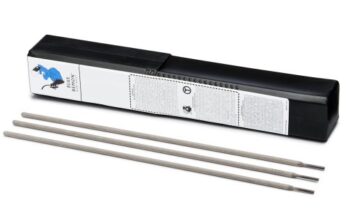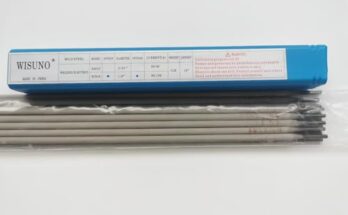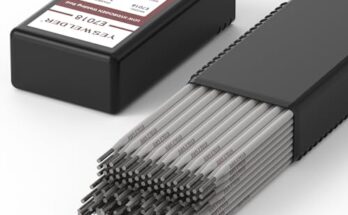Need a strong, versatile welding rod for your next project? Let’s explore the capabilities of the 309L welding rod. This guide will cover its properties, applications, and help you understand when it’s the right choice for your needs.
Before diving into the specifics, it’s crucial to understand what makes 309L welding rod
stand out. This isn’t just any welding rod; it’s a specialized tool with unique characteristics that make it ideal for certain applications.
Chemical Composition and its Significance
The “309L” designation refers to its specific chemical composition. It’s an austenitic stainless steel welding rod, meaning it contains high levels of chromium, nickel, and manganese. These elements contribute significantly to its corrosion resistance. The ‘L’ indicates a low carbon content, which minimizes the risk of carbide precipitation and improves its weldability. This is important because carbide precipitation can cause embrittlement, making the weld weaker and more prone to cracking. The precise percentages of each element can vary slightly depending on the manufacturer, but the key components remain consistent, leading to similar overall performance characteristics. For example, a typical 309L rod might contain roughly 20-23% chromium, 10-14% nickel, and a lesser amount of manganese.
Physical Properties and Weldability
309L boasts excellent mechanical properties, including high tensile strength and ductility. This means it can withstand significant stress without breaking or deforming. Its ductility allows for easy shaping and forming. Furthermore, its weldability is exceptional, making it relatively straightforward to use for various welding processes including gas metal arc welding (GMAW), gas tungsten arc welding (GTAW), and shielded metal arc welding (SMAW). The low carbon content contributes to this easy weldability, and its high melting point allows for the creation of strong, durable welds. Because of its favorable properties, you’ll find it useful in scenarios requiring toughness and resilience in high-temperature environments. Think of it like choosing a high-grade steel for a critical component – you’re prioritizing quality and reliability.
Applications of 309L Welding Rod: Where it Excels
The unique properties of 309L make it suited for specific applications where other welding rods would fall short. Let’s explore a few key areas where this rod shines.
High-Temperature Applications
One of the most significant advantages of 309L is its ability to withstand high temperatures. Its high chromium and nickel content contributes to exceptional heat resistance. This makes it particularly valuable in industries such as power generation, aerospace, and petrochemical processing, where components are routinely exposed to extreme heat. For instance, it might be used to weld parts of a furnace or repair a component in a jet engine. It’s a robust choice when facing prolonged exposure to temperatures significantly above what standard steel can handle. It’s not just about resistance; it’s also about maintaining structural integrity at those elevated temperatures, preventing weakening or failure.
Corrosion-Resistant Welding
The high chromium content grants 309L excellent corrosion resistance. In environments exposed to harsh chemicals, seawater, or other corrosive substances, 309L stands up remarkably well. This is crucial in applications like marine engineering, chemical plants, and wastewater treatment facilities. Imagine welding the pipes of a desalination plant that constantly handles saltwater – 309L offers protection against corrosion, extending the lifespan of the equipment. This resistance isn’t just about longevity; it’s about preventing costly repairs and downtime due to premature failures caused by corrosion.
Comparing 309L to Other Welding Rods: Making the Right Choice
Choosing the right welding rod is critical for the success of any project. Understanding how 309L stacks up against other common welding rods helps ensure you pick the best tool for the job. This section compares it to popular alternatives and explains when to use each.
309L vs. 308L: Subtle but Important Differences
Often confused, 309L and 308L are both austenitic stainless steel welding rods, but their compositions differ slightly. 308L has a lower chromium and higher nickel content compared to 309L. This results in 308L having slightly better corrosion resistance in certain environments, while 309L offers superior high-temperature strength. The choice depends on the specific application needs: prioritize corrosion resistance in milder environments with 308L and high-temperature performance in extreme environments with 309L. Consider the specific requirements – will it be exposed to aggressive chemicals, or high heat – to guide your selection process.
309L vs. 316L: A Matter of Strength and Application
316L is another popular stainless steel welding rod, often used in applications requiring excellent corrosion resistance. However, 309L surpasses 316L in high-temperature applications due to its higher chromium content and different alloying elements. 316L might be preferable for applications with extreme corrosive conditions, while 309L might be more appropriate when high-temperature strength is paramount. This choice highlights the importance of matching the welding rod’s properties to the specific challenges of the application. Choosing between these two relies on carefully analyzing the environmental factors and the required mechanical properties of the finished weld.
Safety Precautions When Using 309L Welding Rod: Protecting Yourself
Welding is inherently dangerous, and using any welding rod, including 309L, demands careful adherence to safety procedures. Protecting yourself is paramount, and it starts with understanding the potential hazards.
Eye and Respiratory Protection: Essential Precautions
The intense light and ultraviolet (UV) radiation emitted during welding can severely damage your eyes, potentially leading to blindness. Always wear appropriate eye protection, such as a welding helmet with a shade appropriate for the welding process. Respiratory protection is also crucial, as welding fumes can be harmful if inhaled. Using a respirator with a proper filter designed for welding fumes is essential. Neglecting these steps can have serious health consequences. Investing in quality personal protective equipment (PPE) is not an expense; it’s an investment in your long-term health and well-being.
Proper Ventilation and Workspace: Maintaining a Safe Environment
Ensure adequate ventilation in your workspace to minimize the concentration of welding fumes. Working in an open, well-ventilated area is ideal. If working indoors, use extraction systems to remove fumes effectively. Additionally, maintain a clean and organized workspace. Clutter can create tripping hazards, and a safe environment minimizes risks. Consider using a welding curtain to create a safe zone, protecting others from potential hazards such as sparks or UV radiation.
Factors Affecting the Cost of 309L Welding Rod: A Closer Look
The cost of 309L welding rod can vary depending on several factors. Understanding these factors helps in making informed purchasing decisions.
Manufacturer and Supplier: Choosing the Right Source
Different manufacturers produce 309L welding rods, and their pricing can vary. Some manufacturers focus on high-quality materials and rigorous quality control, leading to higher prices, while others offer more budget-friendly options. Similarly, different suppliers may have varying markup percentages. Comparing prices from multiple reputable suppliers before making a purchase is recommended. Don’t always choose the cheapest option; balance cost with quality and reliability. Research and compare the reputations of different suppliers to find one that offers a fair price for a high-quality product.
Diameter and Length: Understanding the Size Implications
The diameter and length of the 309L welding rod significantly impact its cost. Larger-diameter rods typically cost more per unit length, as they use more raw materials. Similarly, longer rods will naturally cost more than shorter ones. The size of the rod must match the welding application and the material thickness; using an inappropriately sized rod can lead to inefficient welding and potentially compromise the strength of the weld.
Maintenance and Storage of 309L Welding Rods: Ensuring Quality
Proper maintenance and storage ensure the quality and performance of 309L welding rods. Neglecting this can lead to degradation of the welding rod and compromise the integrity of the final weld.
Proper Storage Conditions: Protecting Against Degradation
Store 309L welding rods in a dry, clean, and cool environment. Exposure to moisture can lead to corrosion and affect the welding performance. Keeping the rods in their original packaging helps prevent contamination and moisture absorption. Ensure the storage area is well-ventilated to prevent the accumulation of humidity. The goal is to maintain the rods in their optimal condition, ensuring their consistent and reliable performance during welding.
Inspecting for Damage Before Use: Ensuring Weld Quality
Always inspect the 309L welding rod for any damage before use. Check for any signs of corrosion, bending, or cracks. Damaged rods should be discarded, as using them could compromise the weld’s integrity and lead to potential failure. This simple inspection step saves time and potentially prevents costly rework or repairs. It’s crucial to prioritize quality and safety. A quick visual inspection can prevent significant problems down the line.
Advanced Techniques and Considerations for 309L Welding
While 309L is relatively straightforward to weld, mastering advanced techniques can significantly improve weld quality and efficiency.
Preheating and Post-Welding Heat Treatment: Optimizing Results
Preheating the base material before welding can reduce the risk of cracking, especially in thicker materials. The optimal preheating temperature depends on several factors, including material thickness and welding process. Post-weld heat treatment (PWHT) can further enhance the properties of the weld, improving its toughness and reducing residual stresses. Both preheating and PWHT are advanced techniques and require a good understanding of metallurgy and welding processes; if you lack experience, seek professional guidance.
Welding Parameters: Fine-Tuning for Optimal Performance
Choosing the appropriate welding parameters, such as current, voltage, and travel speed, significantly impacts the quality of the weld. The optimal parameters depend on several factors, including the welding process (GMAW, GTAW, or SMAW), the thickness of the base material, and the type of filler metal (309L in this case). Experimentation and experience are key to optimizing welding parameters to achieve the best results. However, starting with recommended parameters from the welding rod manufacturer is always a good practice.
Frequently Asked Questions
What is 309L welding rod best for?
309L welding rod is best suited for applications requiring high-temperature strength and corrosion resistance. This makes it ideal for industries such as aerospace, power generation, and chemical processing where components are subjected to extreme heat or harsh corrosive environments. It’s particularly useful for welding stainless steel components that need to withstand significant thermal stress and chemical attack. Learn more about its properties for a deeper understanding of its applicability.
What are the advantages of using 309L?
The primary advantages of 309L include its excellent high-temperature strength, superior corrosion resistance, and good weldability. Its high chromium and nickel content contribute to its superior performance in demanding environments. The low carbon content enhances its weldability, making it a relatively easy rod to work with for experienced welders. This combination of properties makes it a versatile and reliable choice for numerous applications.
How does 309L compare to other stainless steel welding rods?
Compared to other stainless steel welding rods like 308L and 316L, 309L offers superior high-temperature strength. While 308L provides slightly better corrosion resistance in some environments, and 316L is known for its overall corrosion resistance, 309L excels when high-heat performance is crucial. The choice depends entirely on the specific requirements of the project. Understanding the subtle differences between these rods is key to choosing the correct one.
What safety precautions should I take when using 309L?
Always wear appropriate personal protective equipment (PPE), including a welding helmet with the correct shade lens, gloves, and respiratory protection. Ensure adequate ventilation in your workspace to prevent the inhalation of harmful welding fumes. Maintain a clean and organized workspace to minimize tripping hazards. Following these safety precautions is crucial for preventing serious injuries or health problems.
How should I store 309L welding rods?
Store 309L welding rods in a dry, clean, and cool environment to prevent corrosion. Keep them in their original packaging to prevent contamination and moisture absorption. Proper storage helps maintain the quality and performance of the rods, ensuring they are ready for use when needed. Inspect them for damage before use to prevent issues during welding.
What is the typical cost of 309L welding rods?
The cost varies depending on the manufacturer, supplier, rod diameter, and length. Larger-diameter and longer rods typically cost more. Comparing prices from multiple reputable suppliers helps find a balance between cost and quality. Remember that investing in high-quality rods often pays off in the long run by ensuring superior weld quality and minimizing the risk of failure.
Can I use 309L for all types of stainless steel?
While 309L is compatible with many types of stainless steel, it’s crucial to check compatibility with the specific grade of stainless steel you are welding. Incorrect filler metal selection can lead to undesirable weld properties. Always consult the manufacturer’s specifications and recommendations to ensure compatibility and achieve optimal weld performance. Understanding the nuances of material compatibility is essential for reliable welding results.
Final Thoughts
The 309L welding rod presents a powerful solution for welding projects requiring high-temperature strength and excellent corrosion resistance. Its unique properties make it a valuable asset in diverse industries, from aerospace to chemical processing. However, remember that safety is paramount. Always prioritize proper safety equipment, and a clean, well-ventilated workspace. Careful consideration of the application, proper storage, and understanding of the welding parameters are key to achieving strong, durable, and reliable welds. By understanding the properties, applications, and safety considerations of 309L welding rods, you can confidently tackle your next welding project with precision and success. Are you ready to put the power of 309L to work for your next project?


